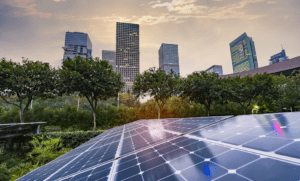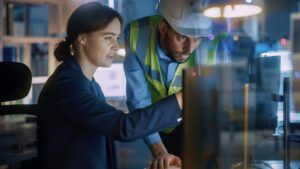Digitization is viewed as a crucial pathway to a sustainable future, but it comes with its challenges. The burgeoning volume of data accumulated in the industrial sector, allied with the rapid growth of streaming content for consumers, is driving high demand for data center capacity.
Recent forecasts suggest that by 2024 data centers will exceed 32 GW of electrical power, on par with that of a medium-sized country. Set alongside sustainable aspirations driven by the growing concerns of climate change and the increase of global initiatives, the pressure is intensifying on the digital infrastructure sector to ensure that its growth strategy has sustainability at its heart.

Setting goals for sustainable digital infrastructure
To improve its environmental credentials and align with the ambitious greenhouse gas reductions of the European Green Deal, industry-leading cloud infrastructure providers and data center operators created the Climate Neutral Data Centre Pact in 2021. Twenty-five companies and 17 associations have agreed to a self-regulatory initiative to make data centers in Europe climate neutral by 2030.
Companies joining the pact represent the most significant industry players in cloud infrastructure and data centers in Europe. The pact targets five pillars in efficiency, green energy, water use, reuse and recycling, and heat reuse. More than anything else, the concerted approach from the industry highlights the growing awareness that sustainability is an essential component of every company’s strategy.
In the past, sustainability was viewed as something that added value to a company’s offerings, but it has quickly escalated into a commercial imperative. The time for talking sustainability is over. Stakeholders are demanding climate action now. If a company cannot walk the talk when it comes to its sustainability ambitions, it simply will not get a seat at the table. Transparency and sustainability will be crucial to winning new projects.
A comprehensive approach to a sustainable data center future
For initial forays into decarbonizing their operations, the natural first step for any company is looking at their internal processes, focusing on improving energy efficiency, which for data centers focuses on power usage effectiveness (PUE). But this myopic focus on energy efficiency, or Scope 1 emissions, will not be enough to deliver the ever more stringent decarbonization targets being set in the boardroom.
Most of the carbon footprint rests in the supply and value chain for many businesses. Looking outside your company’s walls and decarbonizing Scope 3 may feel like a massive undertaking, but it is essential – and possible. To reach net-zero goals, every company in the data center supply chain must focus on the entire value chain, including embodied carbon, product lifecycle, energy procurement, water use, and circularity, including their inbound and outbound supply chain.
A sustainable data center: Five steps for this journey
It may sound a daunting undertaking, but working with a trusted advisor and clearly defining the strategy and implementation phases is something that we have found as key to success. To that end, this short video below outlines a five-step approach to deliver on sustainability targets.
Step One
The journey begins by setting a bold and actionable strategy to achieve a sustainable data center. It is crucial to create one with clear objectives and prioritized actions. These measures must be aligned to the internal expertise and resources by having the teams for design, procurement, facility operations, and sustainability all collaborating. Any goals or commitments should align with science-based, external frameworks.
Step Two
The next step is to implement efficient data center designs. As mentioned earlier, sustainability gains through energy efficiency are currently the focus of most efforts, but the benefits will eventually plateau. However, much work is to be done around the carbon footprint of building materials and the industry. The focus is certainly shifting beyond brick and mortar, ensuring sustainability is baked in at all levels, from the value chain to the equipment sourced to the e-waste leaving a facility. We are starting to see a real narrative forming, and long may it continue.
Step Three
The third step is to drive efficiency in operations. Not only must we make the technology itself more sustainable, but we must also deploy the technology effectively to become more responsible. Digitization and transparency can help achieve this.
Step Four
Step four is to look at the energy inputs and increase the amount of green or renewable energy that is used. This can be in the form of traditional renewable energy sources such as wind or solar, either onsite or offsite through power purchase agreements (PPAs), or more innovative solutions such as microgrids. A microgrid manages distributed energy resources and the interconnected energy loads within a defined electrical boundary, such as a data center. It allows operators to take back control and better manage this uncertain landscape with the mindful implementation of distributed energy sources, married with the advanced energy flexibility provided by a microgrid system.
Step Five
The last step, and one that often presents the greatest challenge, is to decarbonize supply chains. Many companies get bogged down with the emissions resulting from their direct operations when in fact, most supply chains produce five times that amount. As a result, many organizations are now deploying supply chain PPA or VPPA programs similar to Energize and the Gigaton PPA (GPPA) Program to decarbonize their supply chains.
Access the Sustainability eBook
To take a deeper dive on the overarching roadmap to data center sustainability, access the introduction of the “The Sustainability Challenge” eBook. You can review DCD research data and tangible first action steps to move along the sustainability journey.
Over the next weeks, you can follow this route to a sustainable future through additional blog posts and download other chapters of the eBook that guide you through this journey with a look at the strategies driving it, the technologies enabling it, and the shifts in energy usage supporting it.



